Freely Available British and Irish Public Legal Information
[Home] [Databases] [World Law] [Multidatabase Search] [Help] [Feedback]
United Kingdom Statutory Instruments
You are here: BAILII >> Databases >> United Kingdom Statutory Instruments >> The Infrastructure Planning (Applications: Prescribed Forms and Procedure) Regulations 2009 No. 2264
URL: http://www.bailii.org/uk/legis/num_reg/2009/uksi_20092264_en_1.html
[New search] [Help]
The Infrastructure Planning (Applications: Prescribed Forms and Procedure) Regulations 2009
Made
1st September 2009
Laid before Parliament
8th September 2009
Coming into force
1st October 2009
The Secretary of State, in exercise of the powers conferred by sections 37, 42, 48, 51, 56, 58, 59 and 232 of the Planning Act 2008(1), makes the following Regulations:
Citation and commencement
1. These Regulations may be cited as the Infrastructure Planning (Applications: Prescribed Forms and Procedure) Regulations 2009 and shall come into force on 1st October 2009.
Interpretation
2.–(1) In these Regulations–
"the Act" means the Planning Act 2008;
"AONB Conservation Boards" are established under section 86 of the Countryside and Rights of Way Act 2000 (establishment of conservation boards)(2);
"applicant" means a person who either proposes to make an application for an order granting development consent or has made such an application;
"EIA development" and "environmental statement" have the same meaning as given by regulation 2(1) of the Infrastructure Planning (Environmental Impact Assessment) Regulations 2009(3);
"fire and rescue authority" has the same meaning as in section 1 of the Fire and Rescue Services Act 2004 (fire and rescue authorities)(4);
"Integrated Transport Authority" has the same meaning as in section 77 of the Local Transport Act 2008 (change of name of passenger transport authorities and PTAs)(5);
"internal drainage board" has the same meaning as in section 1 of the Land Drainage Act 1991 (internal drainage districts and boards)(6);
"land plan" is the plan produced in accordance with regulation 5(2)(i);
"local resilience forum" has the same meaning as in regulation 4 of the Civil Contingencies Act 2004 (Contingency Planning) Regulations 2005(7);
"marine area" means-
waters in or adjacent to England up to the seaward limits of the territorial sea;
an exclusive economic zone, except any part of an exclusive economic zone in relation to which the Scottish Ministers have functions;
a Renewable Energy Zone, except any part of a Renewable Energy Zone in relation to which the Scottish Ministers have functions;
an area designated under section 1(7) of the Continental Shelf Act 1964(8), except any part of that area which is within a part of an exclusive economic zone or Renewable Energy Zone in relation to which the Scottish ministers have functions;
"police authority" means an authority established under section 3 of the Police Act 1996 (establishment of police authorities)(9);
"preliminary environmental information" has the same meaning as given by regulation 2(1) of the Infrastructure Planning (Environmental Impact Assessment) Regulations 2009;
"regional development agency" means a regional development agency established under section 1 of the Regional Development Agency Act 1998 (establishment)(10);
"Regional Planning Body" means a body recognised by the Secretary of State under section 2 of the Planning and Compulsory Purchase Act 2004 (regional planning bodies)(11);
"registration form" means such a form as may be prescribed from time to time for the purpose of making representations under section 102(4) (interpretation of Chapter 4: "interested party" and other expressions);
"relevant Northern Ireland Department" means the Northern Ireland Department responsible for the matter to which an application or proposed application relates (if more than one department is responsible, the reference is to all of them);
"Renewable Energy Zone" means zones designated under section 84 of the Energy Act 2004 (exploitation of areas outside the territorial sea for energy production)(12);
"replacement land" means the land identified on a plan entitled "Replacement Land Plan" and forming part of the land plan;
"safety zones" means safety zones created under section 95 of the Energy Act 2004 (safety zones around renewable energy installations);
"special category land" means the land identified as forming part of a common, open space, National Trust land or fuel or field garden allotment and on the plan entitled "Special Category Land Plan" and forming part of the land plan;
"Strategic Health Authority" means an authority established under section 13 of the National Health Services Act 2006 (Strategic Health Authorities)(13);
"statutory undertaker" has the same meaning as in section 127 (statutory undertakers land);
"the book of reference" has the meaning given by regulation 7.
(2) Any reference in these Regulations to a section, without more, is a reference to a section of the Act.
Prescribed consultees
3. The persons prescribed for the purposes of section 42(a) (duty to consult) are those listed in column 1 of the table in Schedule 1 to these Regulations, who must be consulted in the circumstances specified in relation to each such person in column 2 of that table.
Publicising a proposed application
4.–(1) This regulation prescribes for the purpose of section 48(1) (duty to publicise), the manner in which an applicant must publicise a proposed application.
(2) The applicant must publish a notice, which must include the matters prescribed by paragraph (3) of this regulation, of the proposed application–
(a) for at least two successive weeks in one or more local newspapers circulating in the vicinity in which the proposed development would be situated;
(b) once in a national newspaper;
(c) once in the London Gazette and, if land in Scotland is affected, the Edinburgh Gazette; and
(d) where the proposed application relates to offshore development–
(i) once in Lloyd´s List; and
(ii) once in an appropriate fishing trade journal.
(3) The matters which the notice must include are–
(a) the name and address of the applicant;
(b) a statement that the applicant intends to make an application for development consent to the Commission;
(c) a statement as to whether the application is EIA development;
(d) a summary of the main proposals, specifying the location or route of the proposed development;
(e) a statement that the documents, plans and maps showing the nature and location of the proposed development are available for inspection free of charge at the places (including at least one address in the vicinity of the proposed development) and times set out in the notice;
(f) the latest date on which those documents, plans and maps will be available for inspection (being a date not earlier than the deadline in sub-paragraph (i));
(g) whether a charge will be made for copies of any of the documents, plans or maps and the amount of any charge;
(h) details of how to respond to the publicity; and
(i) a deadline for receipt of those responses by the applicant, being not less than 28 days following the date when the notice is last published.
Applications for orders granting development consent
5.–(1) An application for an order granting development consent must be made in writing in the form set out in Schedule 2 to these Regulations, which is the form prescribed for the purpose under section 37(3)(b).
(2) The application must be accompanied by–
(a) where applicable, the environmental statement required pursuant to the Infrastructure Planning (Environmental Impact Assessment) Regulation 2009 and any scoping or screening opinions or directions;
(b) the draft proposed order;
(c) an explanatory memorandum explaining the purpose and effect of provisions in the draft order, including in particular any divergences from the model provisions(14);
(d) where applicable, the book of reference;
(e) a copy of any flood risk assessment;
(f) a statement whether the proposal engages one or more of the matters set out in section 79(1) (statutory nuisances and inspections therefor) of the Environmental Protection Act 1990(15), and if so how the applicant proposes to mitigate or limit them;
(g) any report identifying any European site to which regulation 48 of the Conservation (Natural Habitats, &c.) Regulations 1994(16) applies, or any Ramsar site(17), which may be affected by the proposed development, together with sufficient information that will enable the Commission to make an appropriate assessment of the implications for the site if required by regulation 48(1);
(h) if the proposed order would authorise the compulsory acquisition of land or an interest in land or right over land, a statement of reasons and a statement to indicate how an order that contains the authorisation of compulsory acquisition is proposed to be funded;
(i) a land plan identifying–
(i) the land required for, or affected by, the proposed development;
(ii) where applicable, any land over which it is proposed to exercise powers of compulsory acquisition or any right to use land;
(iii) any land in relation to which it is proposed to extinguish easements, servitudes and other private rights; and
(iv) where the land includes special category land and replacement land, that special category and replacement land;
(j) a works plan showing, in relation to existing features–
(i) the proposed location or (for a linear scheme) the proposed route and alignment of the development and works; and
(ii) the limits within which the development and works may be carried out and any limits of deviation provided for in the draft order;
(k) where applicable, a plan identifying any new or altered means of access, stopping up of streets or roads or any diversions, extinguishments or creation of rights of way or public rights of navigation;
(l) where applicable, a plan with accompanying information identifying–
(i) any statutory or non-statutory sites or features of nature conservation such as sites of geological or landscape importance;
(ii) habitats of protected species, important habitats or other diversity features; and
(iii) water bodies in a river basin management plan,
together with an assessment of any effects on such sites, features, habitats or bodies likely to be caused by the proposed development;
(m) where applicable, a plan with accompanying information identifying any statutory or non statutory sites or features of the historic environment, including scheduled monuments, World Heritage sites, listed buildings and other historic structures, archaeological sites and registered battlefields, together with an assessment of any effects on such sites, features or structures likely to be caused by the proposed development;
(n) where applicable, a plan with any accompanying information identifying any Crown land;
(o) any other plans, drawings and sections necessary to describe the proposals for which development consent is sought, showing details of design, external appearance, and the preferred layout of buildings or structures, drainage, surface water management, means of vehicular and pedestrian access, any car parking to be provided, and means of landscaping;
(p) any of the documents prescribed by regulation 6 which are relevant to the particular project;
(q) any other documents considered necessary to support the application; and
(r) if requested by the Commission, three paper copies of the application form and other supporting documents and plans.
(3) Any plans, drawings or sections required to be provided by paragraph (2) shall be no larger than A0 size, shall be drawn to an identified scale (not smaller than 1:2500) and, in the case of plans, shall show the direction of North.
(4) Where a plan comprises three or more separate sheets a key plan must be provided showing the relationship between the different sheets.
(5) The applicant shall make available, at the request of the Commission, all responses to the consultation carried out under Part 5 of the Act (applications for orders granting development consent).
Matters prescribed in relation to applications for specific types of projects
6.–(1) If the application is for the construction or extension of a generating station the application must be accompanied by–
(a) if the application is for a generating station, that is not an offshore generating station–
(i) a statement of who will be responsible for designing and building the connection to the electricity grid; and
(ii) if a gas fuelled generating station, a statement of who will be responsible for designing and building the gas pipeline connection to the generating station; and
(b) if the application is for an offshore generating station–
(i) details of the proposed route and method of installation for any cable; and
(ii) a statement as to whether applications will be made for safety zones.
(2) If the application is for highway related development or for the construction or alteration of a railway, it must be accompanied by section drawings to suitable horizontal and vertical scales, which show, by reference to Ordnance Survey or Chart datum–
(a) the levels of the proposed works, including in particular and where relevant–
(i) ground levels;
(ii) the height of every proposed bridge, viaduct, aqueduct, embankment and elevated guideway;
(iii) the depth of every proposed cutting and tunnel;
(iv) the levels of the bed of any tidal waters or inland waterway in which it is proposed that any works should be situated;
(v) the height of every structure or device (including a cable, but not catenary and related equipment) intended to be erected above, on or below the surface of, or on or beneath the bed of tidal waters or an inland waterway; and
(vi) drainage outfall details for highways;
(b) a cross section of every intended tunnel and any altered gradient of a carriageway or a way forming part of a guided transport system on either side of every level crossing, bridge, tunnel or underpass which would carry the carriageway or way or through which it would pass.
(3) If the application is for the construction or alteration of harbour facilities, it must be accompanied by a statement setting out why the making of the order is desirable in the interests of–
(a) securing the improvement, maintenance or management of the harbour in an efficient and economical manner; or
(b) facilitating the efficient and economic transport of goods or passengers by sea or in the interests of the recreational use of sea-going ships.
(4) If the application is for the construction of a pipeline, it must be accompanied by details of–
(a) the name of the proposed pipeline;
(b) the owner of the proposed pipeline;
(c) the start and end point of the proposed pipeline;
(d) the length of the proposed pipeline in kilometres;
(e) the external diameter in millimetres of the proposed pipeline;
(f) what will be conveyed by the proposed pipeline; and
(g) whether the grant of any rights in land or consents to road or river crossing works are required and if so whether they can be obtained by agreement.
(5) If the application is for the construction or alteration of a hazardous waste facility the application must be accompanied by a statement detailing the proposed purpose of the facility and an estimate of the annual capacity of the plant for the final disposal or recovery of hazardous waste.
(6) If the application is for the construction of a dam or reservoir the application must be accompanied by a statement setting out what if any recreational amenities will be made available.
Meaning of "book of reference" in these Regulations
7.–(1) In these Regulations "book of reference" means a book, in five Parts, together with any relevant plan, and which–
(a) in Part 1 contains the names and addresses for service of each person within Categories 1 and 2 as set out in section 57 (categories for purposes of section 56(2)(d)) in respect of any land which it is proposed shall be subject to-
(i) powers of compulsory acquisition;
(ii) rights to use land, including the right to attach brackets or other equipment to buildings; or
(iii) rights to carry out protective works to buildings;
(b) in Part 2 contains the names and addresses for service of each person within Category 3 as set out in section 57;
(c) in Part 3 contains the names of all those entitled to enjoy easements or other private rights over land (including private rights of navigation over water) which it is proposed shall be extinguished, suspended or interfered with;
(d) in Part 4 specifies the owner of any Crown interest in the land which is proposed to be used for the purposes of the order for which application is being made;
(e) in Part 5 specifies land–
(i) the acquisition of which is subject to special parliamentary procedure;
(ii) which is special category land;
(iii) which is replacement land; and
for each plot of such land within which it is intended that all or part of the proposed development and works shall be carried out, the area in square metres of that plot.
(2) In this regulation–
"land" includes any interest in or right over land;
"protective works" in relation to a building means-
underpinning, strengthening and any other works the purpose of which is to prevent damage which may be caused to the building by the carrying out, maintenance or use of the authorised development and authorised works; and
any works the purpose of which is to remedy any damage which has been caused to the building by the carrying out, maintenance or use of the authorised development and authorised works; and
"relevant plan" includes the land plan (containing the replacement land and special category land).
Notice of accepted application
8.–(1) The persons prescribed for the purposes of section 56(2) (notifying persons of accepted application) are those listed in column 1 of the table in Schedule 1 to these regulations, who must be notified in the circumstances specified in relation to each such person in column 3 of that table.
(2) The notice to be given under section 56(2) must include–
(a) the name and address of the applicant;
(b) a statement to the effect that an application for an order granting development consent has been made to the Commission and that the Commission has accepted the application;
(c) the reference number applied to that application by the Commission;
(d) a summary of the main proposals, specifying the location or route of the proposed development;
(e) a map showing the location or route of the proposed development;
(f) a statement saying whether the application is EIA development;
(g) a statement that a copy of the application form and its accompanying documents, plans and maps are available for inspection free of charge at the places (including at least one address in the vicinity of the proposed development) and times set out in the notice;
(h) the latest date on which those documents will be available for inspection (being a date not earlier than the deadline date set under section 56(5));
(i) a statement as to whether a charge will be made for copies of any of the documents and if so the amount of any charge; and
(j) details of how to make representations (giving notice of any interest in, or objection to, the application), and if the notice is given on or after the 1st March 2010, a statement that such representations must be made on a registration form.
Publicising an accepted application
9.–(1) The applicant must publish a notice, which must include the matters prescribed by paragraph (4) of this regulation, of the accepted application, in the same manner as is prescribed in relation to a proposed application, by regulation 4(2)(a) to (d), and also in accordance with paragraph (2) and where applicable (3), of this regulation.
(2) The notice must be displayed at, or as close as reasonably practicable to, the site of the proposed development at a place accessible to the public;
(3) Where the proposed development consists of, or includes, a linear scheme exceeding five kilometres in length, the notice must be displayed at intervals of not more than five kilometres along the whole proposed route of the works, except where this is impracticable due to the land in question being covered in water.
(4) The matters which the notice must include are–
(a) the name and address of the applicant;
(b) a statement to the effect that an application for an order granting development consent has been made to the Commission and that the Commission has accepted the application;
(c) the reference number applied to the application by the Commission;
(d) a summary of the main proposals, specifying the location or route of the proposed development;
(e) a statement saying whether the application is EIA development;
(f) a statement that a copy of the application form and its accompanying documents, plans and maps are available for inspection free of charge at the places (including at least one address in the vicinity of the proposed development) and times set out in the notice;
(g) the latest date on which those documents will be available for inspection (being a date not earlier than the deadline date under sub-paragraph (j));
(h) a statement as to whether a charge will be made for copies of any of the documents and if so the amount of any charge;
(i) details of how to make representations (giving notice of any interest in, or objection to the application), and if the notice is published on or after 1st March 2010, a statement that such representations must be made on a registration form; and
(j) a deadline for the receipt by the Commission of those representations being not less than 28 days following the date that the notice is last published.
Certifying compliance with section 56 of the Act
10.–(1) The form prescribed for the purposes of section 58(2) (certifying compliance with section 56 of the Act) is the form set out in Schedule 3 to these Regulations.
(2) Within the period of 10 working days immediately following the deadline set under regulation 9(4), the applicant must send to the Commission–
(a) the certificate of compliance in the form mentioned in paragraph (1); and
(b) where the applicant applies for an order granting development consent which includes a request to authorise compulsory acquisition of land or of an interest or right over land, a notice of persons interest in the land to which that request relates, in the form set out in Schedule 4 to these Regulations.
Advice
11.–(1) The Commission must keep a written record of any advice given in accordance with section 51(1) (advice for potential applicants and others), including in particular–
(a) who requested the advice;
(b) the matter in respect of which advice was requested;
(c) the relevant application; and
(d) the date when the advice was given.
(2) The Commission must also maintain on a website that is accessible to the public, a record in respect of any advice given in accordance with section 51, which must include the same particulars as those required by paragraph (1).
(3) If a Commissioner has been involved in giving advice pursuant to section 51(1), that Commissioner may not be appointed–
(a) to a Panel responsible for examining or deciding the relevant application;
(b) as the single Commissioner responsible for examining and reporting on that application; or
(c) to the Council for the purpose of deciding that application.
(4) In this regulation "relevant application" means the application or proposed application in connection with which the Commission has given advice in accordance with section 51(1).
Transitional matters
12.–(1) An application made before 1st October 2011 shall be deemed to have met the requirements of section 55(3)(e) if the Commission is satisfied that before making the application the applicant has, on or after 1st October 2007 but before 1st October 2009–
(a) commenced consultation with the persons set out in section 42 (including those persons listed in the table in Schedule 1 in the circumstances set out in column 2) about the proposed application;
(b) commenced consultation with people living in the vicinity of the land about the proposed application, having first consulted the local authority about how to conduct the consultation; and
(c) publicised the proposed application in a manner which, had regulation 4 been in force at the date of such publication, would have substantially fulfilled the requirements of that regulation.
(2) If paragraph (1) has been complied with, the applicant must submit with the application a report–
(a) detailing the consultation carried out under paragraph (1)(b); and
(b) demonstrating how any relevant responses to the consultation have been taken into account when deciding the terms of the application.
(3) Any applicant relying on the provisions in this regulation shall notify the Commission of the proposed application before any application is submitted.
(4) (a) In this regulation–
"the land" means the land to which the proposed application relates or any part of the land; and
"relevant response" means–
a response from a person consulted under paragraphs (1)(a) and (b) that is received by the applicant before any applicable deadline; and
any response to publicity under paragraph (1)(c) that is received by the applicant before any applicable deadline.
the applicable deadline must be no less than 28 days following the last date that a proposed application was published.
Signed by authority of the Secretary of State for Communities and Local Government
Bill McKenzie
Parliamentary Under Secretary of State
Department for Communities and Local Government
1st September 2009
SCHEDULES
Regulations 3 and 8(1)
SCHEDULE 1
Table
| Column 1; Consultee | Column 2; Circumstances when that person must be consulted about a proposed application. | Column 3; Circumstances when that person must be notified about an application. |
|---|---|---|
| The Welsh Ministers | All proposed applications likely to affect land in Wales | All applications likely to affect land in Wales |
| The Scottish Executive | All proposed applications likely to affect land in Scotland | All applications likely to affect land in Scotland |
| The relevant Northern Ireland Department | All proposed applications likely to affect land in Northern Ireland | All applications likely to affect land in Northern Ireland |
| The relevant Regional Planning Body | All proposed applications likely to affect land in England and Wales | All applications likely to affect land in England and Wales |
| The Health and Safety Executive | All cases | All cases |
| The relevant Strategic Health Authority | All proposed applications likely to affect land in England and Wales | All applications likely to affect land in England |
| The relevant Health Board(18) | All proposed applications likely to affect land in Scotland | All applications likely to affect land in Scotland |
| Natural England(19) | All proposed applications likely to affect land in England | All applications likely to affect land in England |
| The Historic Buildings and Monuments Commission for England | All proposed applications likely to affect land in England | All applications likely to affect land in England |
| The relevant fire and rescue authority | All cases | All cases |
| The relevant police authority | All cases | All cases |
| The relevant parish council, or, where the application relates to land Wales or Scotland the relevant community council | All cases | All cases |
| The Environment Agency | All proposed applications likely to affect land in England and/or Wales | All applications likely to affect land in England and/or Wales |
| The Scottish Environment Protection Agency | All proposal applications likely to affect land in Scotland | All applications likely to affect land in Scotland |
| The Commission for Architecture and the Built Environment | All proposed applications likely to affect land in England | All applications likely to affect land in England |
| The relevant Regional Development Agency | All cases | All cases |
| The Equality and Human Rights Commission | All proposed applications likely to affect land in England and Wales | All applications likely to affect land in England and Wales |
| The Scottish Human Rights Commission | All proposed applications likely to affect land in Scotland | All applications likely to affect land in Scotland |
| The Commission for Sustainable Development | All cases | All cases |
| AONB Conservation Boards | All proposed applications likely to affect an AONB that is managed by a Conservation Board | All applications likely to affect an AONB that is managed by a Conservation Board. |
| Royal Commission on Ancient and Historical Monuments of Wales | All proposed applications likely to affect the historic environment in Wales | All proposed applications likely to affect the historic environment in Wales |
| The Countryside Council for Wales | All proposed applications likely to affect land in Wales | All applications likely to affect land in Wales |
| The Homes and Communities Agency(20) | All proposed applications likely to have an effect on its areas of responsibility | All applications likely to have an effect on its areas of responsibility |
| The Joint Nature Conservation Committee | All proposed applications likely to affect the marine environment | All applications likely to affect the marine environment. |
| The Commission for Rural Communities | All proposed applications likely to affect rural communities in England | All applications likely to affect rural communities in England |
| Scottish Natural Heritage | All proposed applications likely to affect land in Scotland | All applications likely to affect land in Scotland |
| The Maritime and Coastguard Agency | All proposed applications likely to affect the maritime or coastal environment, or the shipping industry | All applications likely to affect the maritime or coastal environment, or the shipping industry. |
| The Marine and Fisheries Agency | All proposed applications likely to affect the marine area in England and Wales | Where the proposal would involve carrying on any activity in the marine area in England and Wales |
| The Scottish Fisheries Protection Agency | All proposed applications likely to affect the fisheries industry in Scotland | All applications likely to affect the fisheries industry of Scotland |
| The Civil Aviation Authority | All proposed applications relating to airports or which are likely to affect an airport or its current or future operation | All applications relating to airports or which are likely to affect an airport or its current or future operation |
| The Highways Agency | All proposed applications likely to affect road or transport operation and/or planning on roads for which the Secretary of State for Transport is the highway authority. | All applications likely to affect road or transport operation and/or planning on roads for which the Secretary of State for Transport is the highway authority. |
| Integrated Transport Authorities (ITAs) and Passenger Transport Executives (PTEs) | All proposed applications likely to affect transport within, to or from the relevant integrated transport area of the ITA or PTE | All applications likely to affect transport within, to or from the relevant integrated transport area of the ITA or PTE |
| The relevant Highways Authority | All proposed applications likely to have an impact on the road network or the volume of traffic in the vicinity of the proposal | All applications likely to have an impact on the road network or the volume of traffic in the vicinity of the proposal |
| Transport for London | All proposed applications likely to affect transport within, to or from Greater London | All applications likely to affect transport within, to or from Greater London |
| The Rail Passengers Council | All proposed applications likely to affect rail passenger transport | All applications likely to affect rail passenger transport |
| The Disabled Persons Transport Advisory Committee | All proposed applications likely to affect access to transport for disabled people | All applications likely to affect access to transport for disabled people |
| The Coal Authority | All proposed applications that lie within areas of past, present or future coal mining. | All applications that lie within areas of past, present or future coal mining. |
| The Office of Rail Regulation and approved operators(21) | All proposed applications likely to affect the rail transport industry | All applications likely to affect the rail transport industry |
| The Gas and Electricity Markets Authority | All proposed applications likely to affect gas and electricity markets | All applications likely to affect gas and electricity markets |
| The Water Services Regulation Authority | All proposed applications likely to affect the water industry in England and Wales | All applications likely to affect the water industry in England and Wales |
| The Water Industry Commission of Scotland | All proposed applications likely to affect the water industry in Scotland | All proposed applications likely to affect the water industry in Scotland |
| The relevant waste regulation authority | All proposed applications likely to affect waste infrastructure | All applications likely to affect waste infrastructure |
| The relevant internal drainage board | All proposed applications likely to increase the risk of flooding in that area or where the proposals relate to an area known to be an area of flood risk | All applications likely to increase the risk of flooding in that area or where the proposals relate to an area know to be an area of flood risk |
| The British Waterways Board | All proposed applications likely to have an impact on inland waterways or land adjacent to inland waterways | All applications likely to have an impact on inland waterways or land adjacent to inland waterways |
| Trinity House(22) | All proposed applications likely to affect navigation in tidal waters | All applications likely to affect navigation in tidal waters |
| The Health Protection Agency | All proposed applications likely to involve chemicals, poisons or radiation which could potentially cause harm to people | All applications likely to involve chemicals, poisons or radiation which could potentially cause harm to people |
| The relevant local resilience forum | All cases | All cases |
| Relevant statutory undertakers | All proposed applications likely to affect their functions as statutory undertakers | All applications likely to affect their functions as statutory undertakers |
| The Crown Estate Commissioners | All proposed applications likely to impact on the Crown Estate | All applications likely to impact on the Crown Estate |
| The Forestry Commission | All proposed applications likely to affect the protection or expansion of forests and woodlands | All applications likely to affect the protection or expansion of forests and woodlands |
Note to Table
"relevant", in relation to a body, shall mean the body which has responsibility for the location where the proposals may or will be sited or has responsibility for an area which neighbours that location.
Regulation 5 and 6
SCHEDULE 2
APPLICATION FORM
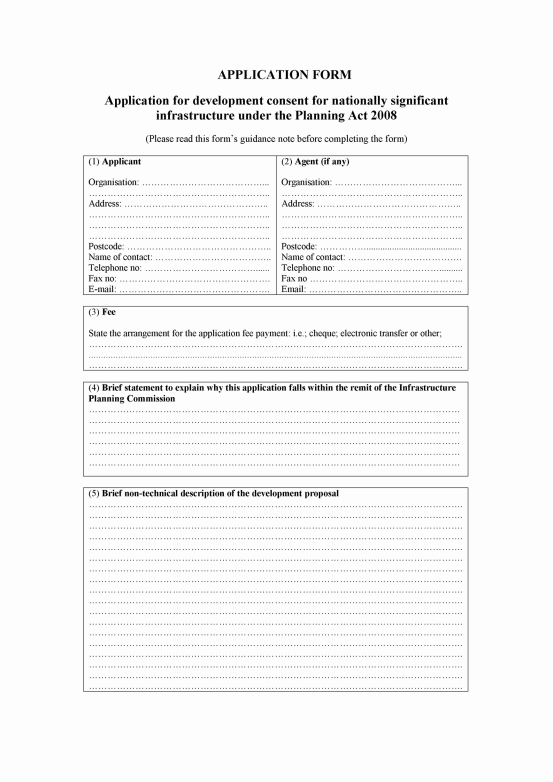 View a larger version of this image
View a larger version of this image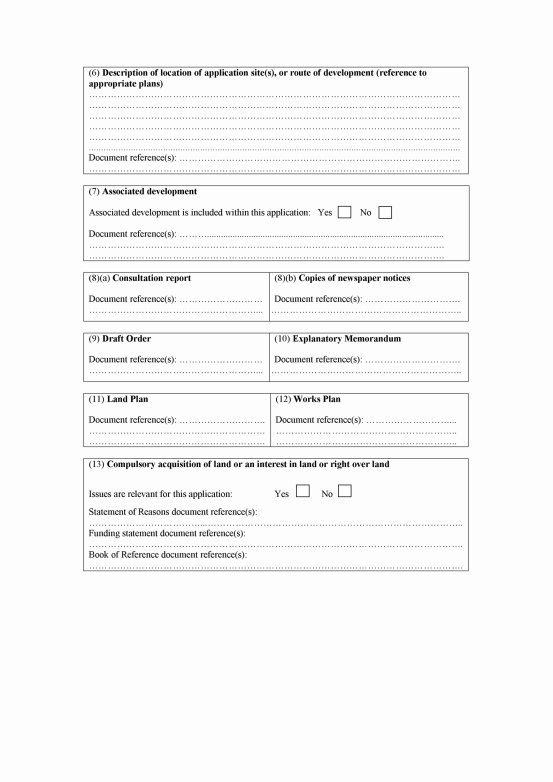 View a larger version of this image
View a larger version of this image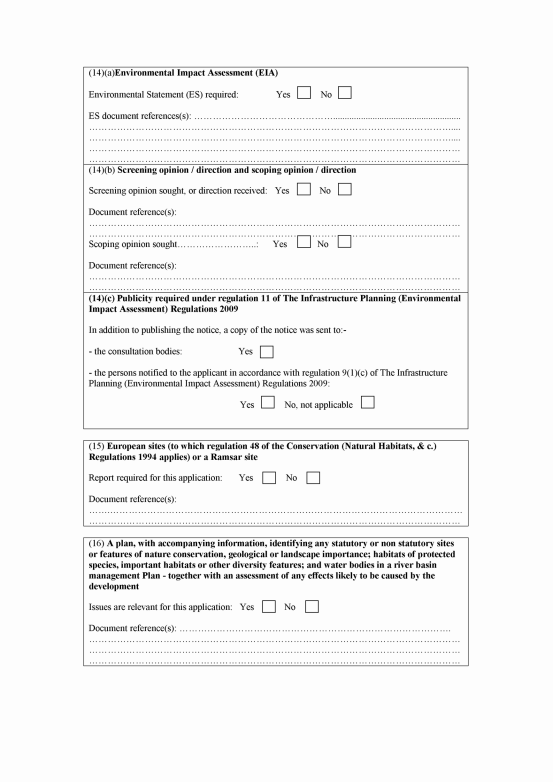 View a larger version of this image
View a larger version of this image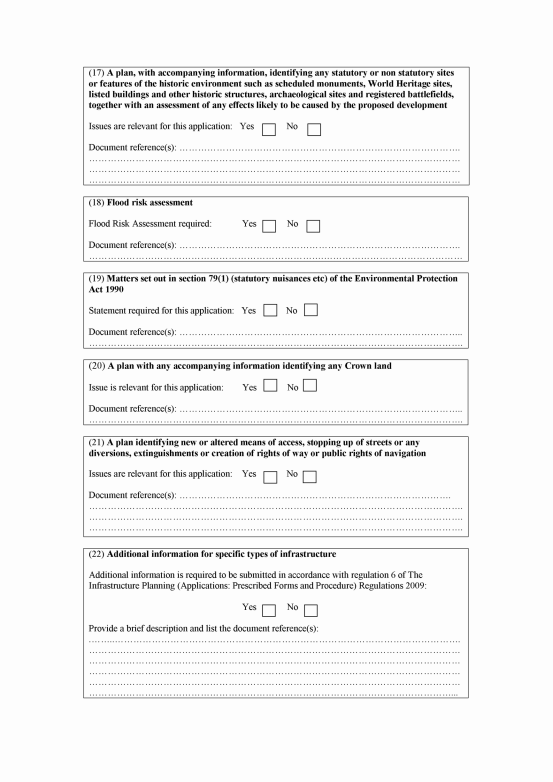 View a larger version of this image
View a larger version of this image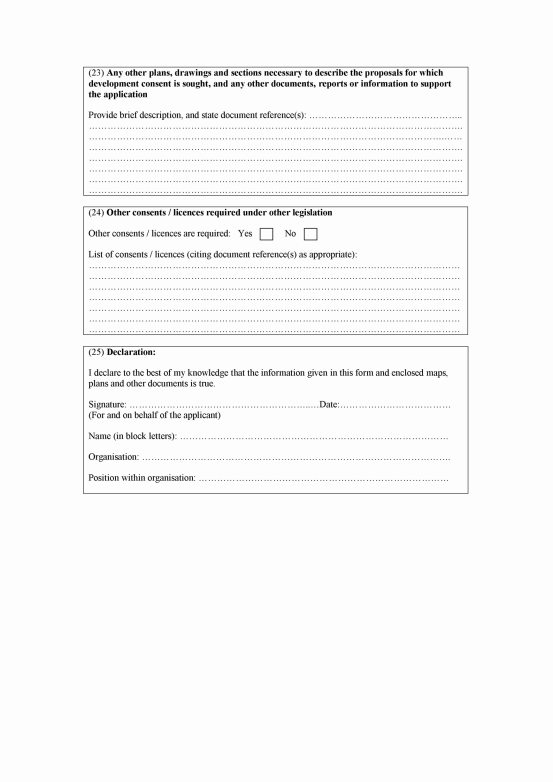 View a larger version of this image
View a larger version of this imageRegulation 10(2)(a)
SCHEDULE 3
CERTIFICATE UNDER REGULATION 10
Certifying compliance with section 56 of the Act.
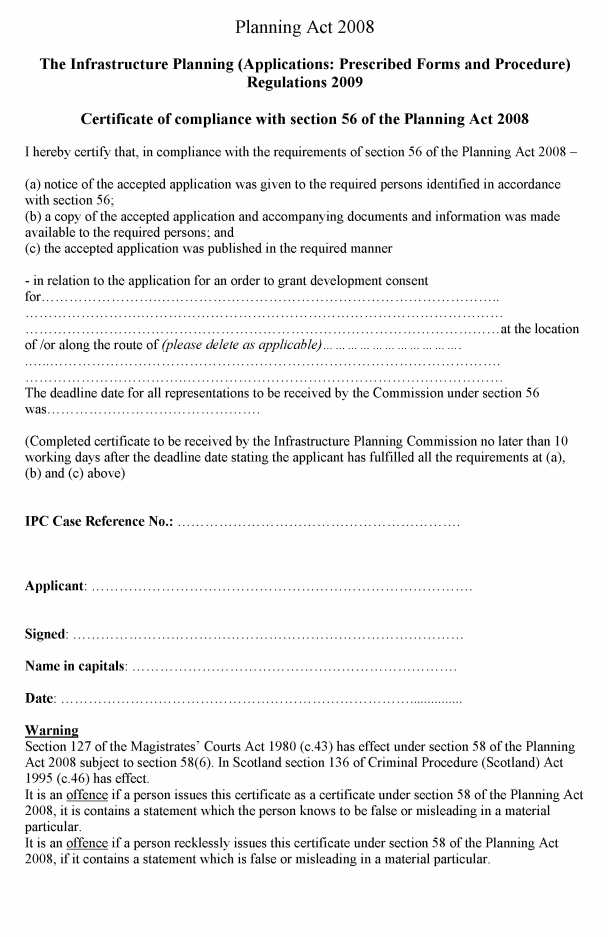 View a larger version of this image
View a larger version of this imageRegulation 10(2)(b)
SCHEDULE 4
Notice under section 59
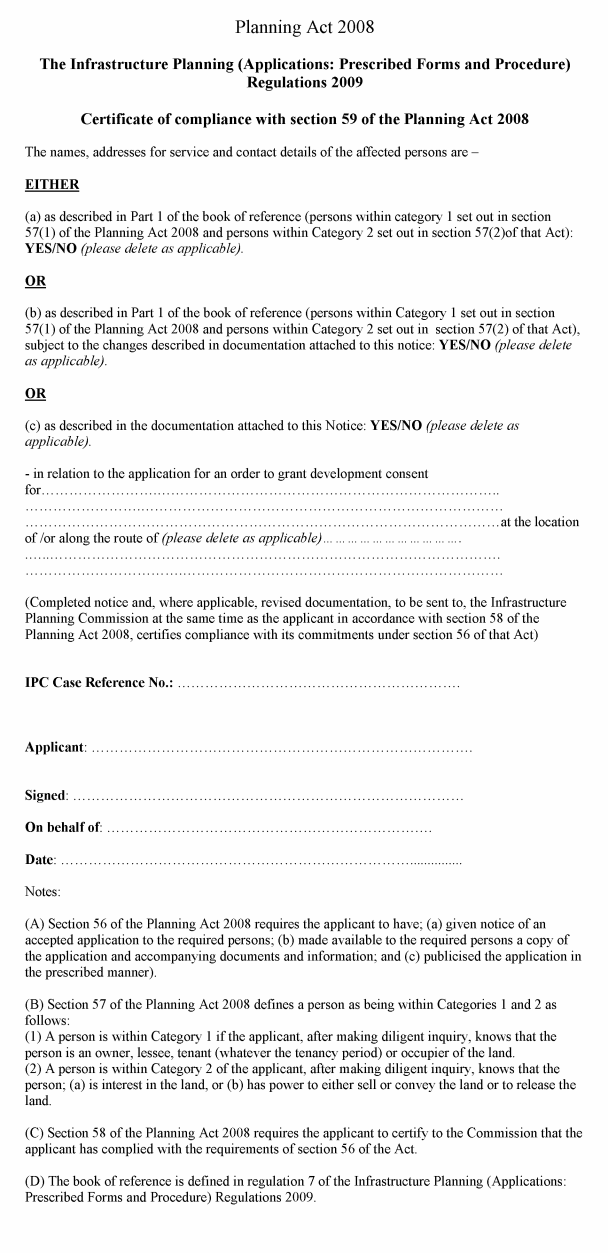 View a larger version of this image
View a larger version of this imageEXPLANATORY NOTE
(This note is not part of the Regulations)
The Planning Act 2008 (c.29) establishes the Infrastructure Planning Commission and provides for the granting of development consent for certain types of nationally significant infrastructure projects.
These regulations prescribe various matters in connection with the making of an application for development consent. Regulations 3 and 4 set out the procedural requirements for publicising a proposed application. Regulations 5 and 6 deal with the making of the application itself and provides for an application form which is set out in Schedule 2. Regulations 8, 9 and 10 set out the procedural requirements for publicising the application once it has been accepted by the Commission and what needs to be done when an order requires compulsory acquisition of land. Regulation 11 sets out the procedure that must be followed when the Commission gives advice. Regulation 12 sets out the procedural matters for applications made prior to 1st October 2011 where consultation has commenced between October 2007 and October 2009.
An Impact Assessment has not been prepared for most of these regulations as the policy options do not have an additional impact on business, charities or the public sector beyond what was examined in the Impact Assessment that accompanied the Planning Bill when it was introduced in Parliament on 27th November 2007. That Impact Assessment can be found on the Communities and Local Government website (http://www.communities.gov.uk). An Impact Assessment has been prepared in relation to the transitional provisions in regulation 12. This assessment has been placed in the library of each House of Parliament and copies many be obtained from NSID, Department of Communities and Local Government, Eland House, Bressenden Place, London, SW1E 5DU (telephone 020 7944 0810).
2000 c.37. Section 86 was amended by the Planning and Compulsory Purchase Act 2004, sections 118(2), 120, Sch 7, para 23(a) and (b), Sch 9 and by the Natural Environment and Rural Communities Act 2006, section 105(1), Sch 11, Pt 1, para 164(c). Back [2]
S.I. 2009/2263 Back [3]
2004 c.21. Section 1 was amended by the Civil Contingencies Act 2004, section 31(1), Sch 2, Pt 1, para 10(1),(2). Back [4]
S.I. 2005/ 2042. Back [7]
1964 c.29. Sub-section 1(7) was amended by the Oil and Gas (Enterprise) Act 1982, section 37, Sch 3, para 1. Back [8]
See S.I. 2009/2265 Back [14]
1990 c.43. Section 79(1) is amended by section 2 of the Noise and Statutory Nuisance Act 1993 (c.40; sections 107 and 120 of, and Schedules 17 and 22 to, the Environment Act 1995 (c.25); section 101 of the Clean Neighbourhoods and Environment Act 2005 (c.16); and, in respect of Scotland, sections 109, 110 and 112 of the Public Health etc (Scotland) Act 2008 (asp.5). Back [15]
S.I. 1994/2716. Regulation 48 was amended by S.I. 2007/1843 in respect of England and Wales and by S.S.I. 2007/80 in respect of Scotland. Back [16]
See section 77 of the Countryside and Rights of Way Act 2000 c.37 for the definition of Ramsar site. Back [17]
See section 2 of the National Health Service (Scotland) Act 1978 (c.29) Back [18]
See section 1 of the Natural Environment and Rural Communities Act 2006 (c.16). Back [19]
See section 2 of the Housing and Regeneration Act 2008 (c.17) Back [20]
For the definition of "approved operators" see section 25 of the Planning Act 2008. Back [21]
The Corporation of Trinity House of Deptford Strond. Back [22]
